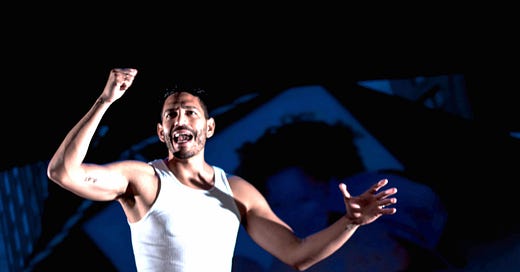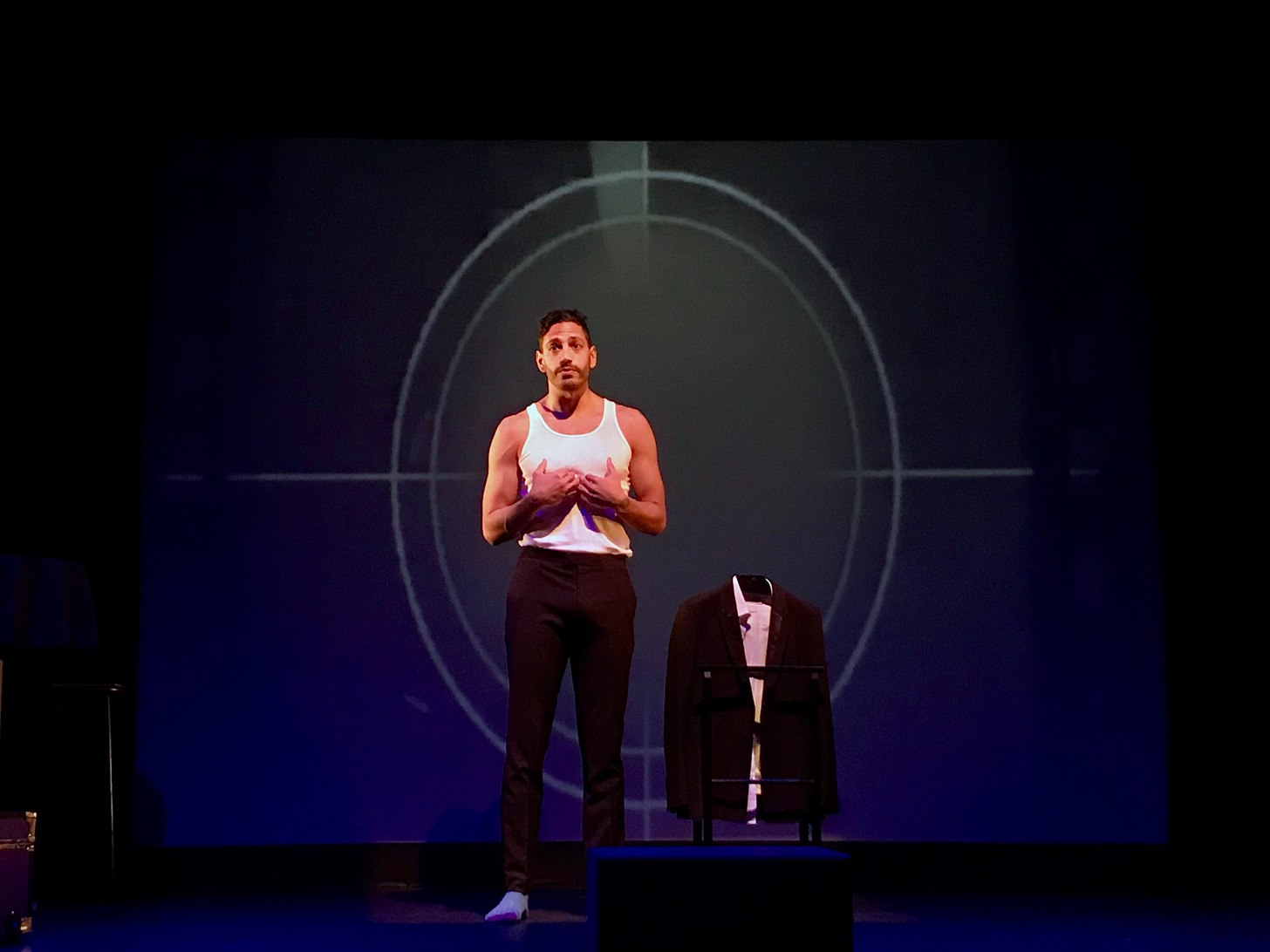It started with a collective breath.
“Inhale,” director Daniel Banks whispered, cradling a pregnant pause after the initial command. “...and exhale.”
The lights dimmed throughout the theater as a warm breeze glided out of every audience member’s mouth. Suddenly, this collection of strangers packed into City Theater’s intimate black box space were reborn as a community, unified by the even pace of steady breathing and the desire to hear a story. Jonathan Gomez, the onstage musician, then transported us to the bustling streets of mid-80s Queens with a hurried and frantic drum beat. But the drums fell quiet as playwright and actor Christopher Rivas leapt onto the stage in nothing but a pair of white briefs and a matching undershirt, a tapestry of stick-and-poke tattoos adorning his legs. Rivas, with boyish enthusiasm, then introduced his childhood idol and title character: James Bond.
“The Real James Bond Was…Dominican,” follows Rivas’ personal journey of identity, masculinity and self-discovery after learning about the real-life inspiration for Ian Fleming’s James Bond — a Dominican man named Porfilio Rubirosa. In true 007 fashion, Rubirosa was a larger than life playboy, a skilled diplomat, a vengeful assassin, an elusive spy, a racecar driver and even a champion polo player. The action of the play weaves through time as Rivas, born from a Dominican father and Columbian mother, imagines what life would have been like if his beloved boyhood hero more accurately represented the real Rubirosa and, by proxy, himself.
Throughout the show, Rivas grappled with code-switching and masking large parts of his identity, much like the real Rubirosa was known to do. Rivas painfully recounts the shame he often feels about his more visible Latino features, particularly his nose. As a child, he said, he was told by an aunt to sleep with a clothespin latched to the bridge of his nose to prevent it from widening as he grew older. Slowly, the audience realized there was a clothespin waiting at every seat. Rivas instructed everyone to clamp the pin on their noses. With curious expression, the crowd scanned the room and saw immediately the difference between those of us with petite noses and those of us who would never measure up to this derived standard of beauty.
The entire production, Rivas informs the audience of the complex aspects of his feelings on race and masculinity. Each time he discusses another layer of his identity, he cleverly puts on an additional layer of clothing. While he begins the show in his tabula rasa undergarments, he ends it dressed in a tailored suit reminiscent of Rubirosa in his prime.
He further embodies Rubirosa when Rivas perched himself on a stool center stage and rocked his hips, morphing the humble stool into a saddle atop a mighty steed careening down a polo field. Gomez kept pace and drummed out the sound of hooves digging into fresh earth. With Rivas’ left hand, he grasped the imaginary reins, and with his right, he transformed a shoehorn into a polo mallet and swung for the match-winning point with a swagger perfectly befitting an international playboy.
Unlike typical one-person shows that feature mountains of monologues or frequently switching between characters, Rivas relies heavily on an honest and literal dialogue with his audience. This production is an exercise in radical presence. It’s not something to consume; it’s a production actively built by the audience with Rivas as the leader. Rivas challenges his audience to become his ensemble. He clearly carries the show, but he also compels the audience to support and engage with him.
“I always say, I don’t make theater; I make church,” Rivas said near the top of the show.
Throughout the production, Rivas projected famous Rubirosa quotes across the back wall of the stage and asked for audience members to read each one out loud. While the first pair of quotes were read with hesitation, the audience slowly sunk into the comfort of a late-semester seminar with a beloved professor.
“Share with me your heart and soul so that I may be whole…I mean it,” Rubirosa once said.
After the show, Banks encouraged the audience to stay and emulate Rubirosa’s spirit and initiated what he called a “story circle.” He led the congregation once again in a breathing exercise before asking everyone to partner up and share initial thoughts and feelings about the show. At the conclusion of the partner sharing, Banks warmly invited any audience member who felt moved by the performance to share “their story.”
An older woman’s voice crackled with tears as she spoke of the guilt she feels, having not adequately prepared her mixed race daughter for the cruelty of a racist world.
“I just didn’t know,” she whispered through her tears. “I didn’t know she would have to face all this.”
And instead of experiencing those feelings in isolation, she was met with a sense of belonging when a younger woman raised her hand and shared her own experiences as the white mother of multi-racial children.
The story circle served as a healing balm on the wounds of society, a place for communion and a home for all.
“Inhale,” Banks asked us one final time. “...And exhale.”





